As the happy owner of a .22 LR Mini Revolver, which I finally reviewed nearly two years ago, I jumped at the opportunity to borrow one of North American Arms‘ newest creations, the 4″ Sidewinder. Instead of requiring the complete removal of the cylinder in order to reload — a process which many people find complicated in NAA’s revolvers — the Sidewinder employs a traditional swing-out cylinder with an actual extractor mechanism . . .
https://www.youtube.com/watch?v=RW-_kEhj9Bc
Despite being a new firearm that lacks “microstamping” capability, it’s still California legal. Thanks to an exemption for single-action revolvers that hold at least five rounds (not a typo) and meet minimum overall length and barrel length requirements, NAA is able to sell some of its new revolvers in the Golden State. For the Sidewinder, it needed a 4″ barrel to meet that OAL figure.
Of course, that isn’t the only reason to slap a longer barrel onto a handgun. This Sidewinder benefits from a longer sight radius than its stubby siblings, and it’ll generate higher velocities from both .22 LR and .22 WMR rounds. Handy indeed, as you’ll have your choice of…
… a 4″ Sidewinder in .22 WMR only or with both a .22 WMR and a .22 LR cylinder.
Swapping out the cylinders is a simple affair. Just remove the flathead bolt from the bottom front of the frame and the cylinder crane will slide out.
Install the other cylinder, snug down the bolt, and you’re back in business. The fit between crane and frame is top notch. In fact, as is the case with the other NAA Minis I’ve owned and played with, fit, finish, and machining are all exemplary. Tolerances are snug, everything that should line up flush does so exactingly, and the action is precise and solid.
As mentioned in the previous review, don’t confuse these guns for cheap novelties. They may be absurdly small — cute, even — and because of that there is an obvious novelty factor, but they’re high quality, reliable, stainless steel revolvers that are made to be used.
The knurled part on the cylinder pin is a spring-mounted sleeve. Pull it forwards to clear the locking trunion thing under the rear of the barrel, then the cylinder can be rotated outwards for loading or unloading. Unlike the standard Mini Revolver, on which the cylinder pin is removed entirely and then used as a ram rod to eject the empty brass one at a time, the Sidewinder’s pin works as a normal extractor plunger with star extractor.
In fact, with .22 LR if you give it a firm tap with the ol’ index finger, it’ll pretty consistently eject all five cases as seen in the video above. .22 WMR cases are too long to eject clear out of the cylinder, and the extra pressure also causes them to stick a bit more. Additionally, their extra length and width demand more concentration due to tight clearances with the grip panel and recoil shield.
The front sight is a polished post.
And the rear is the Mini Revolver standard frame notch. It’s visible once the hammer is cocked.
Rudimentary, to be sure, but they aligned much more easily and more repeatably for me than the ramped front and same rear on my 1-1/8″ barrel Mini. Still, it ain’t a bullseye pistol.
For folks who really do want to eke out the accuracy potential of these little wheel guns, NAA offers a handful of models with real sights. Adjustable target sights, even. And don’t scoff; the Minis actually are mechanically accurate enough to keep a good shooter engaged. The main stumbling block with this model is the sights.
Not that the trigger helps it any.
It actually isn’t a bad trigger, with only a touch of creep before a decent break and very little travel overall, but at ~4.5 lbs it’s heavy. Especially for a single action revolver. The small size and convex curve make it feel even heavier than it actually is, too.
At any rate, the end result was 3″ to 6″ groups at 15 yards, depending on how bad the flyer or flyers were. Again, that’s mostly due to inconsistencies with sight alignment followed by a trigger that measures under 5 lbs but feels more like 11.
On The Range
The magnum-framed Mini Revolvers are noticeably easier to shoot than the LR-framed versions, and it’s all thanks to the larger and fatter grip.
I can shoot this bad boy faster and more accurately than my LR. Of course, it doesn’t fit in my jeans fifth pocket.
For whatever reason I was more accurate when shooting .22 WMR. Just running around goofing off and shooting offhand at my steel silhouette, there was more of that great steel target gong feedback when shooting the mags.
That said, I’m definitely faster when shooting Long Rifles. The frame never shifted in my grip and the front sight stayed on target better, leaving me able to fire as quickly as I could thumb that hammer with my left thumb.
Which, for the record, is a lot of fun.
Another benefit of the longer barrel is the group size when shooting rat shot (aka snake shot, e.g. CCI shotshells). In fact, I was surprised by just how much tighter the groups actually were. With the 1-1/8″ barrel, the .22 LR rat shot spread out to at least a 12″ diameter from only 10 feet away. With the 4″ barrel, the spread was barely over 3″ (and about a 2″ spread at 6 feet). Considering how tiny the #12 shot is in these shells and how sparse the patterns often are, this is a huge difference and it makes the 4″ version significantly more effective for snakes and other little pests.
Conclusion
NAA’s Mini Revolvers are really fun little guns. They’re novel, but they aren’t novelties. They’ve proven themselves in self-defense shootings, and they come in sizes so darn tiny that there’s no excuse for leaving it home. Heck, I’ve had my 1-1/8″ barrel .22 LR in everything from jeans fifth pockets, NAA’s belt buckles, the key / gum / business card pocket inside a suit jacket’s larger pocket, and even in my boardshorts while doing various watersports. Somehow it’s managed to stay out of any “lady parts,” but the same can’t be said for everyone.
Of course, with a 4″ barrel and the magnum frame, this Sidewinder is giving up some of that incredible concealability. But it brings to the table swappable cylinders, a longer sight radius, tighter groups with rat shot, and a significantly more manageable grip size. Plus, it can enjoy the California sun. And the swing-out cylinder of the Sidewinder is a faster, more user-friendly upgrade.
Specifications (North American Arms 4″ Sidewinder):
Caliber: .22 WMR or .22 WMR and .22 LR convertible cylinders
Action: Single action revolver
Barrel: 4 inches
Weight: 8 ounces unloaded
Length: 7.5 inches
Height: 2.875 inches
Capacity: 5 rounds
MSRP: $508 ($396 in .22 WMR only)
Ratings (out of five stars):
Accuracy: * * *
The post front sight and longer sight radius allowed me to put up better groups than with my 1-1/8″ Mini. However, that rear sight is still a big hindrance to consistent alignment. Mechanically accurate or not, it’s hard to shoot it for groups with these sights.
Ergonomics: * * *
Also one star better than the .22 LR version. Larger size equates to a better grip and more control.
Reliability: * * * * *
It’s reliable. Strong primer strikes, good mechanicals, great machining and fit. Rust-resistant stainless steel construction.
Customize This: * * * *
Lots of grip options, tons of holster options, lasers and other accessories, different cylinders and custom shop finishes, etc.
Concealed Carry: * * * *
Tiny and light, but not as tiny or as light as the LR-framed versions.
Overall: * * * *
It’s fun, it’s reliable, it’s built very well. The ability to swap between two calibers is always nice, and the swing-out cylinder is a definite upgrade. I dig the Sidewinder.

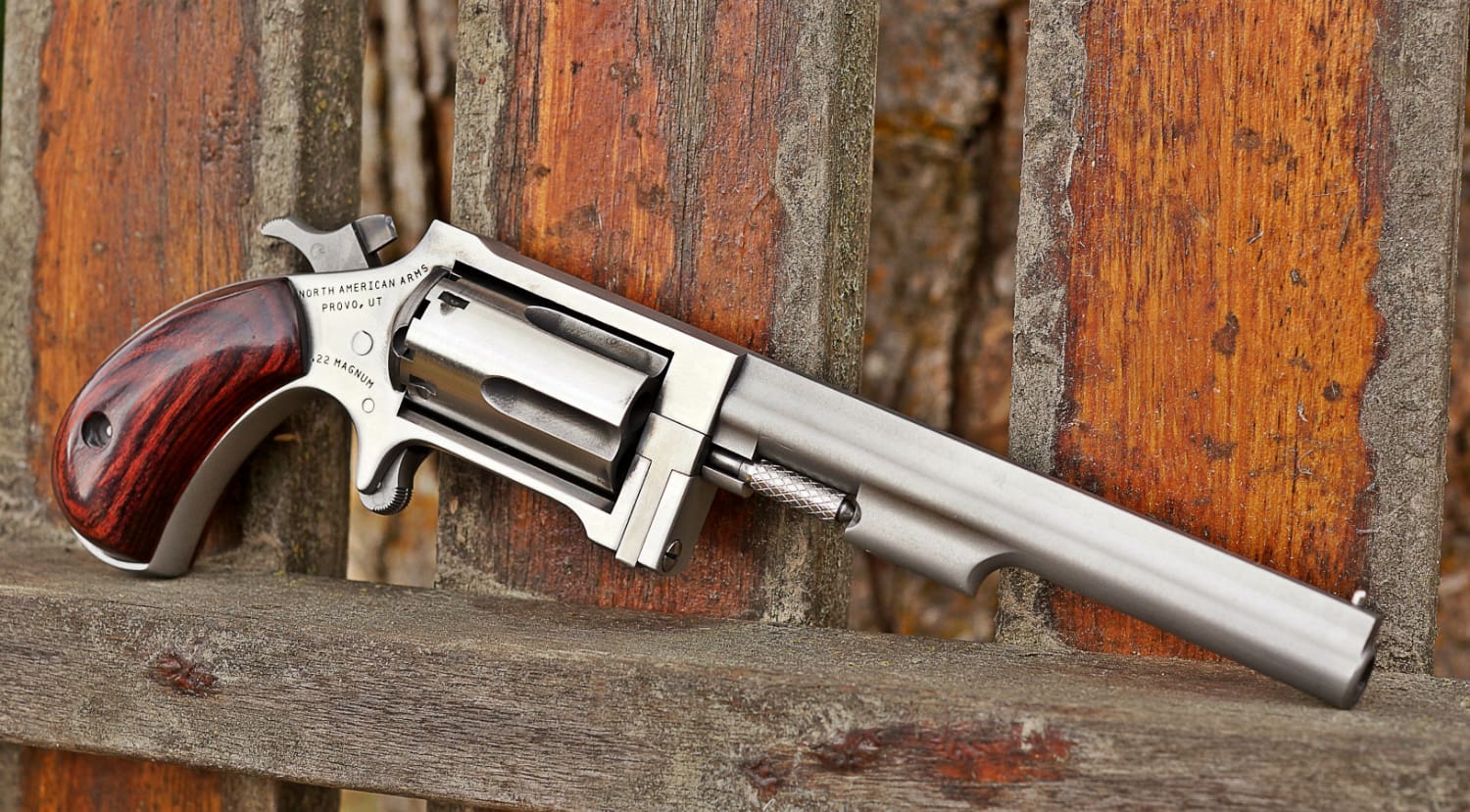
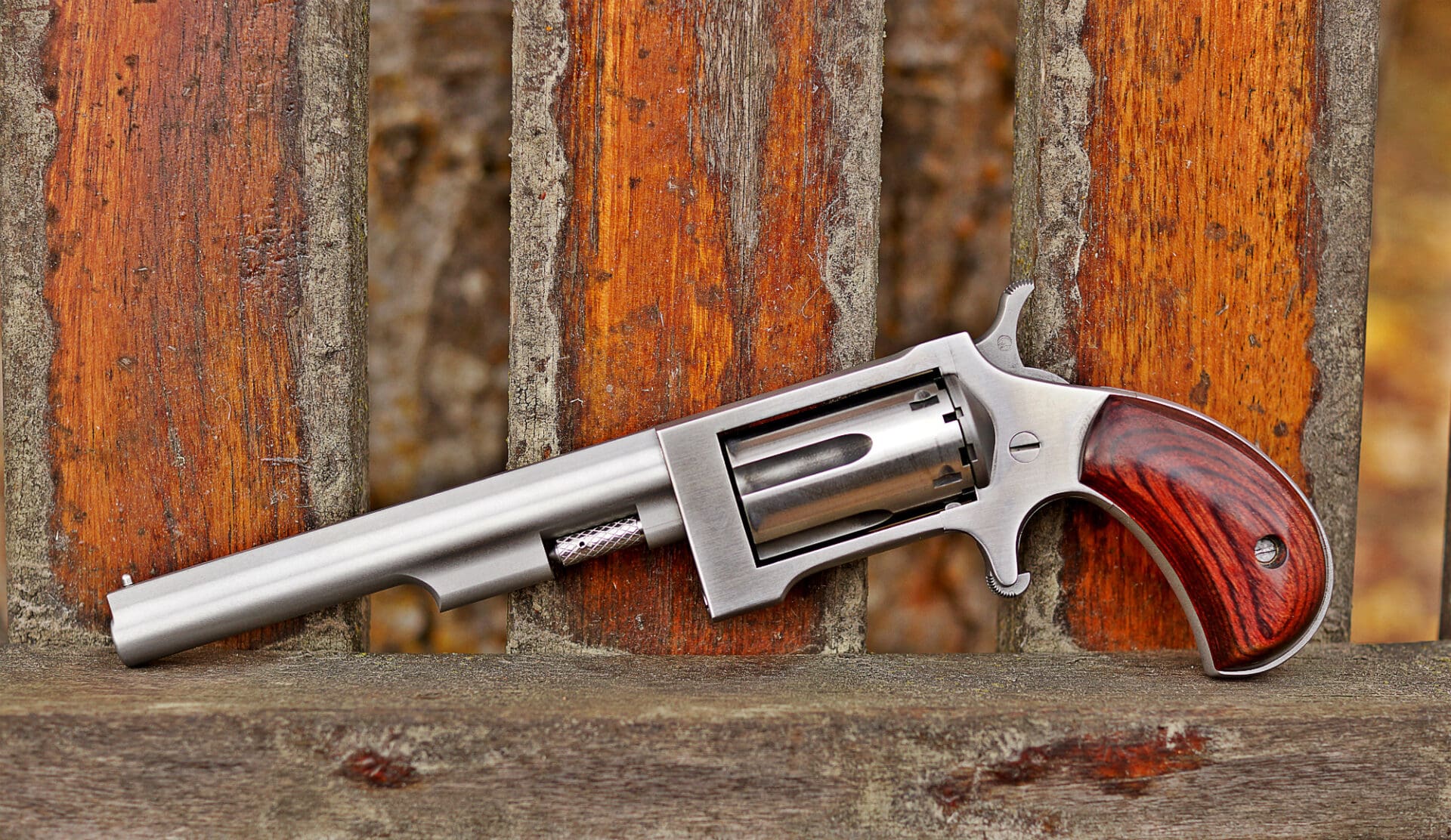
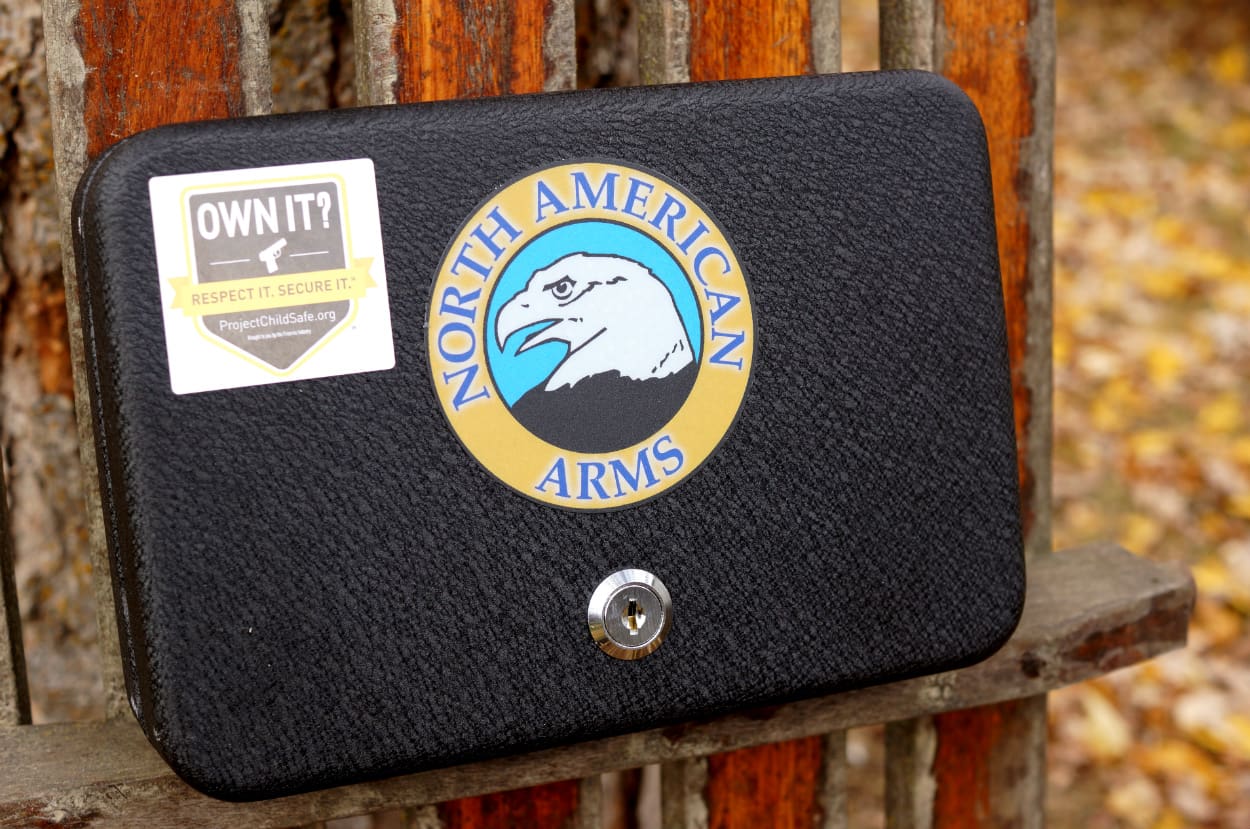
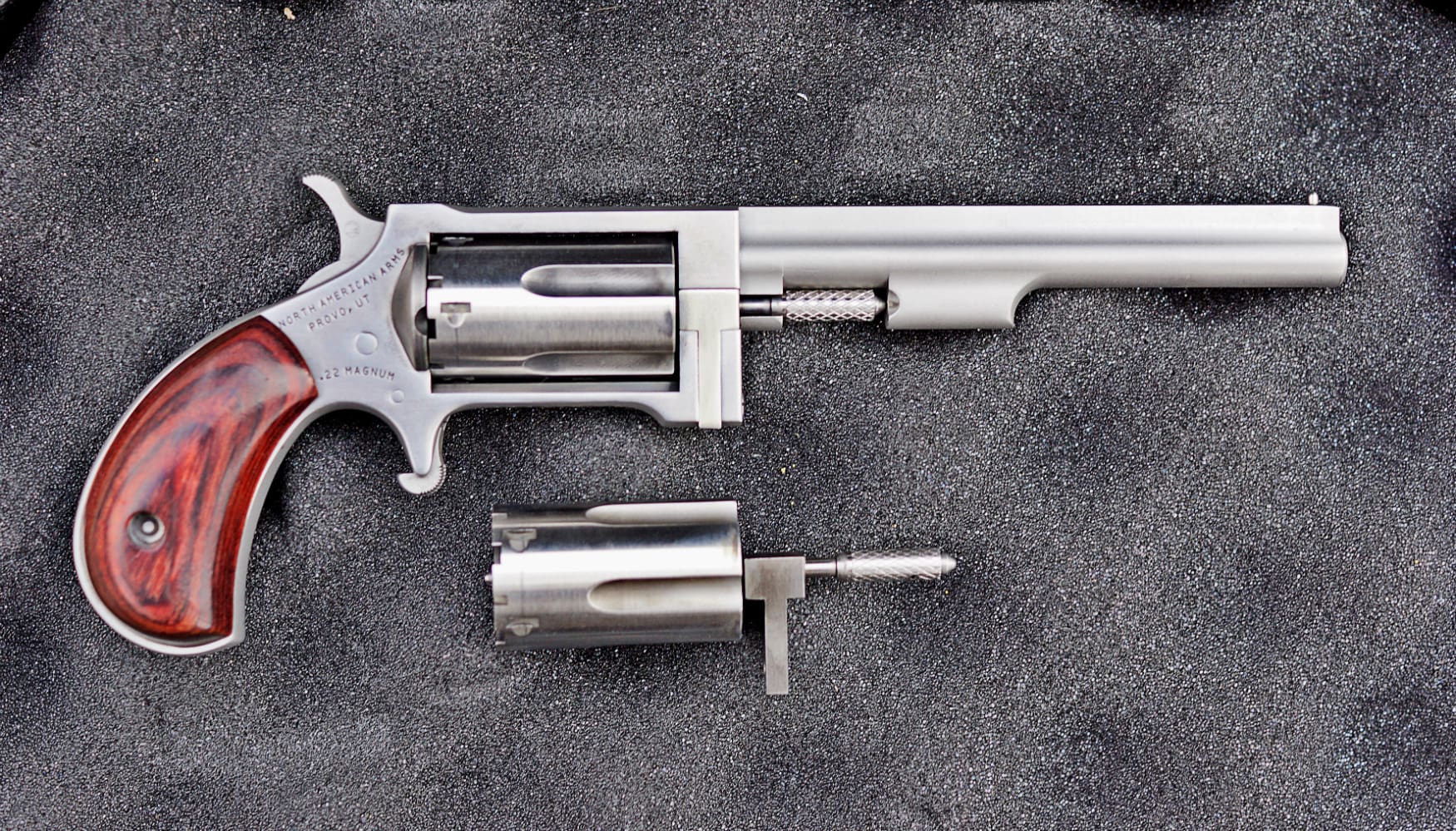

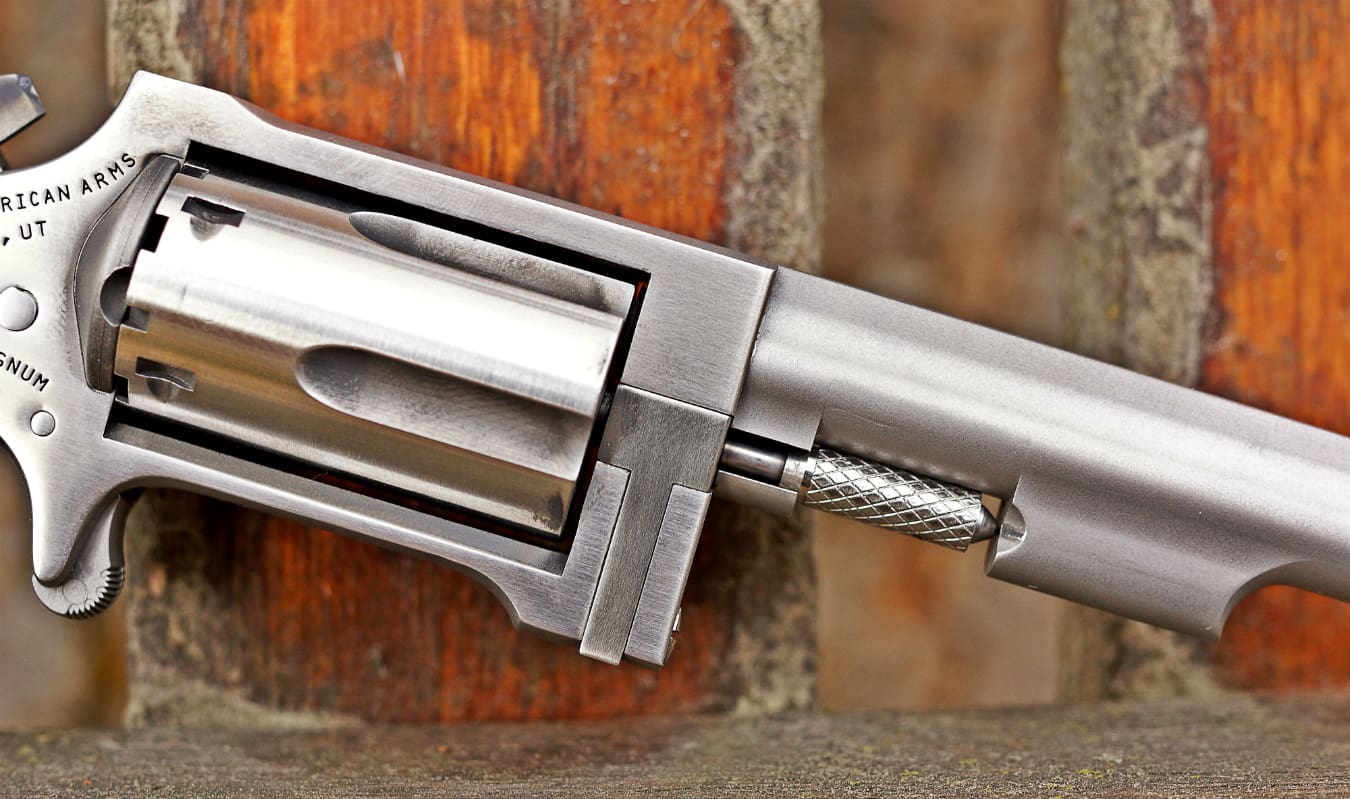
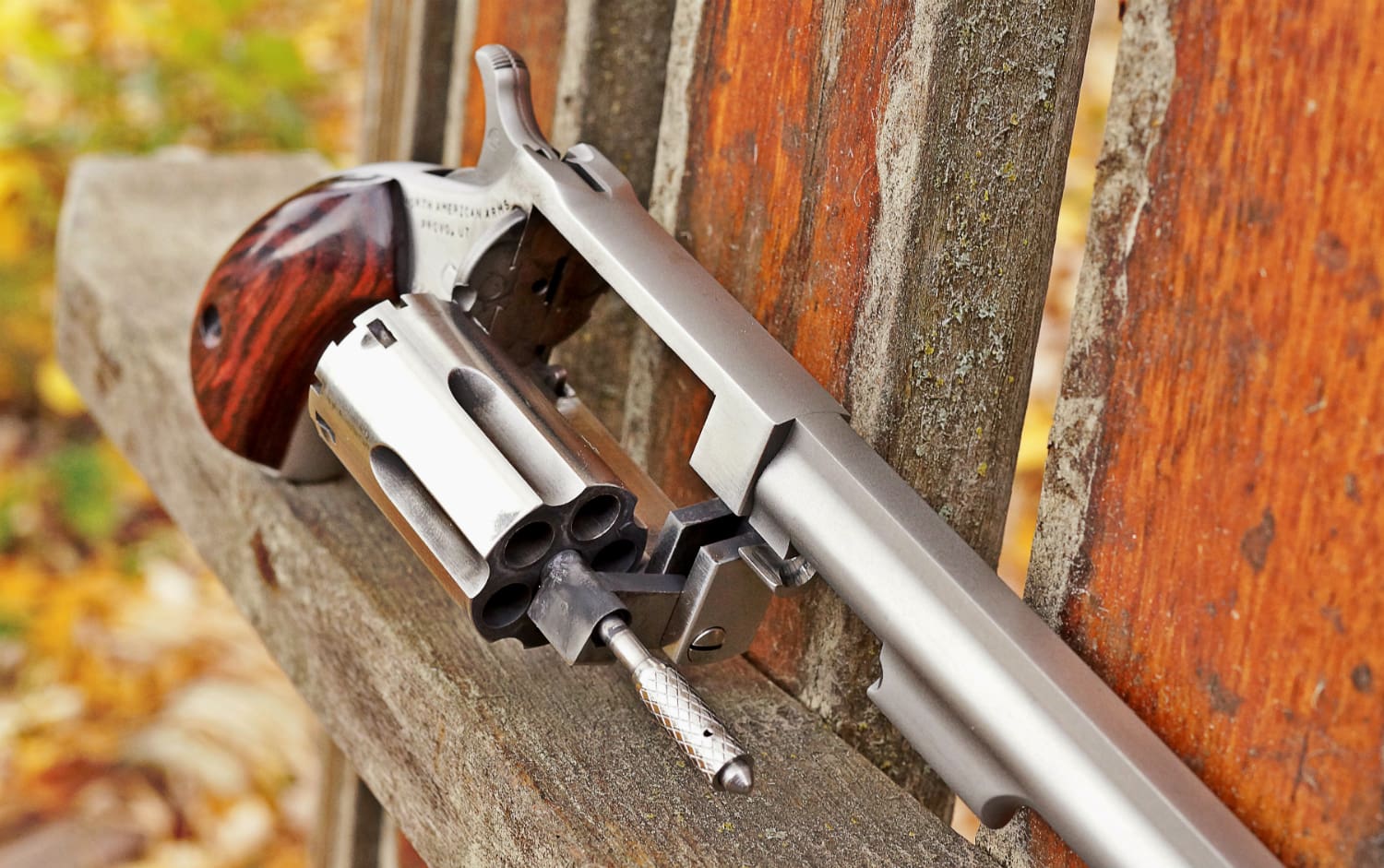

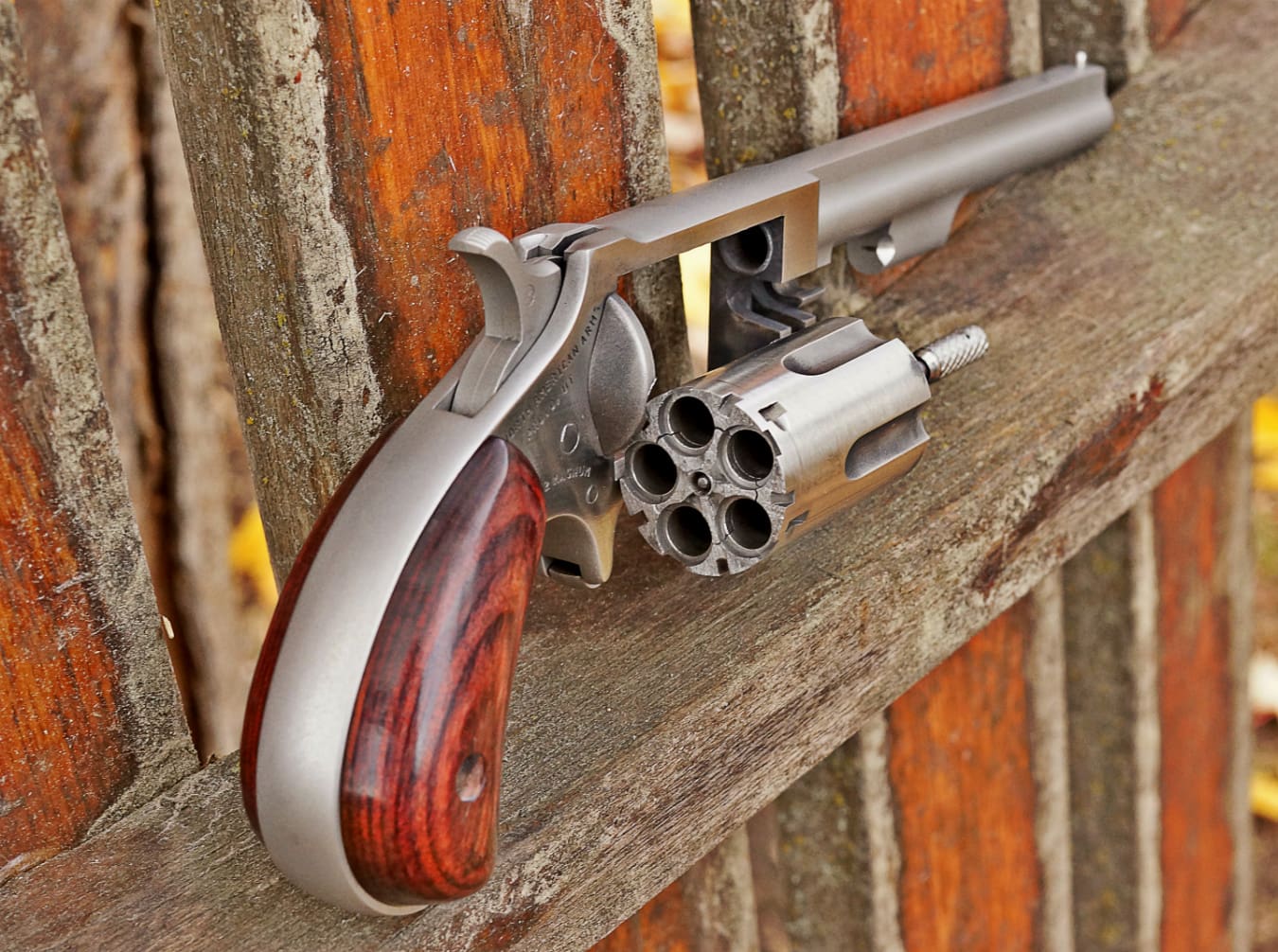
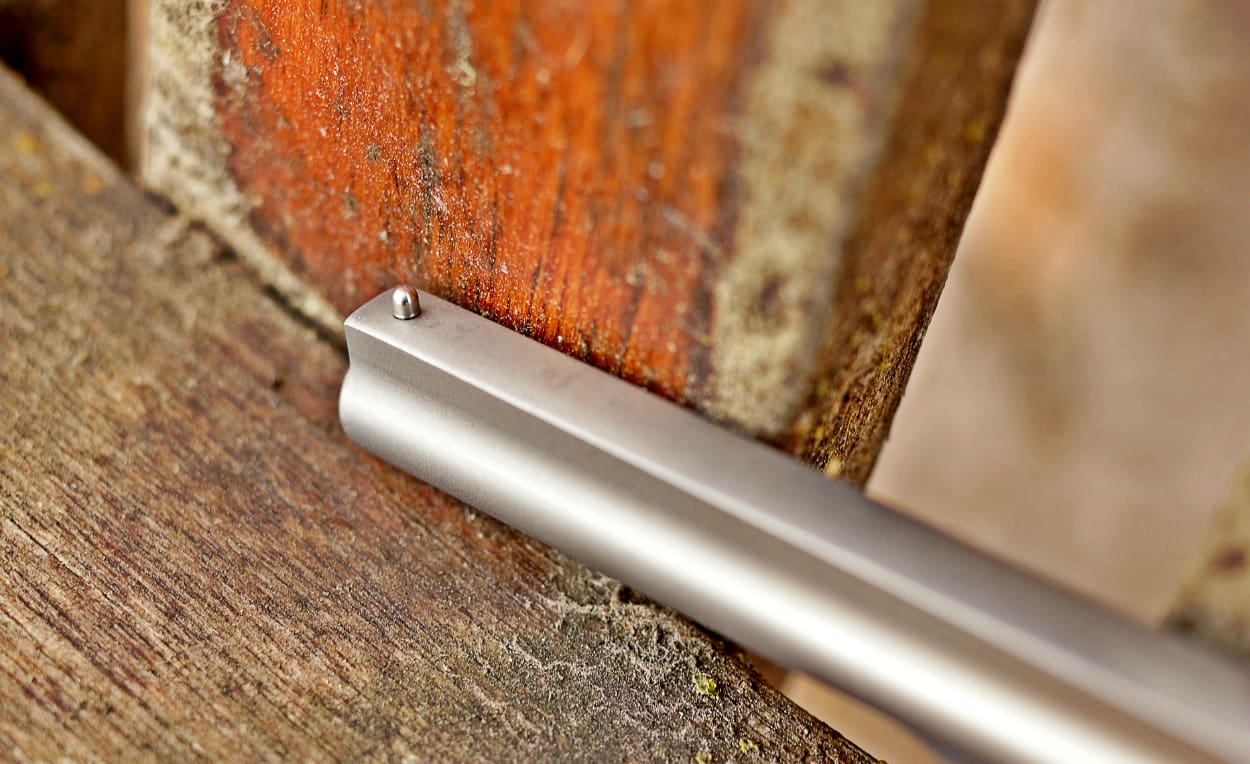
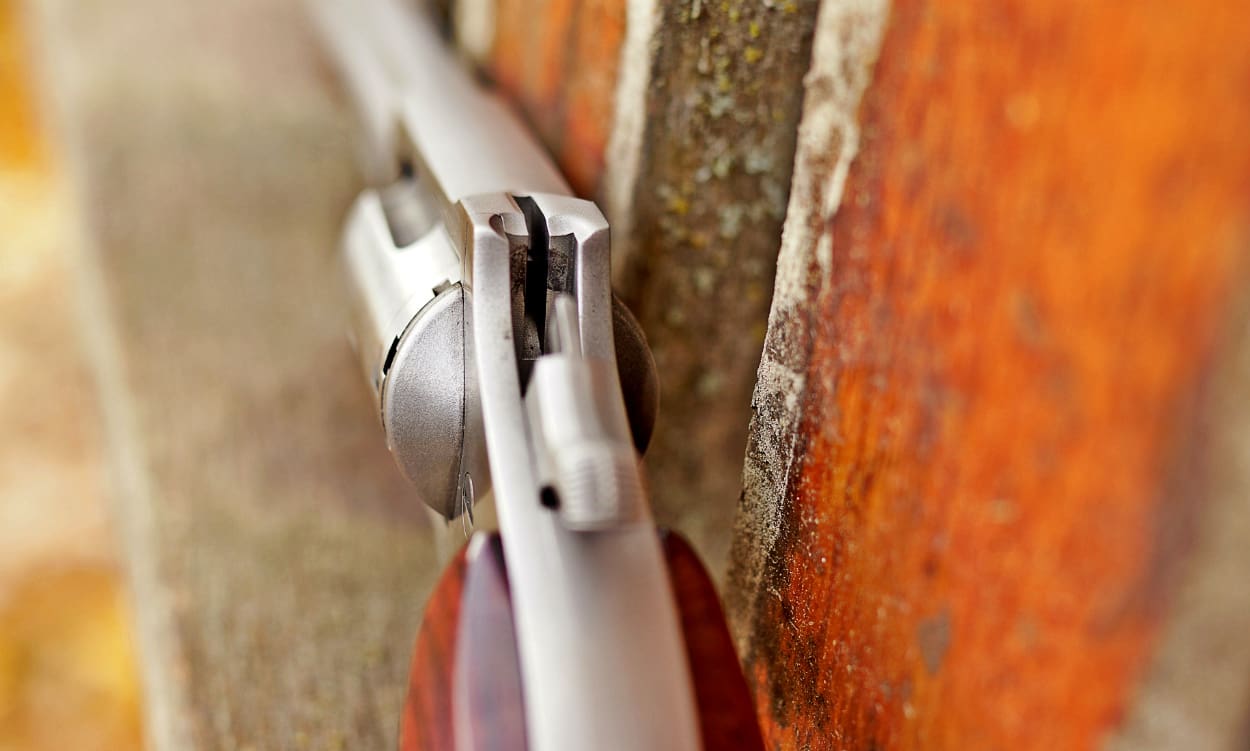
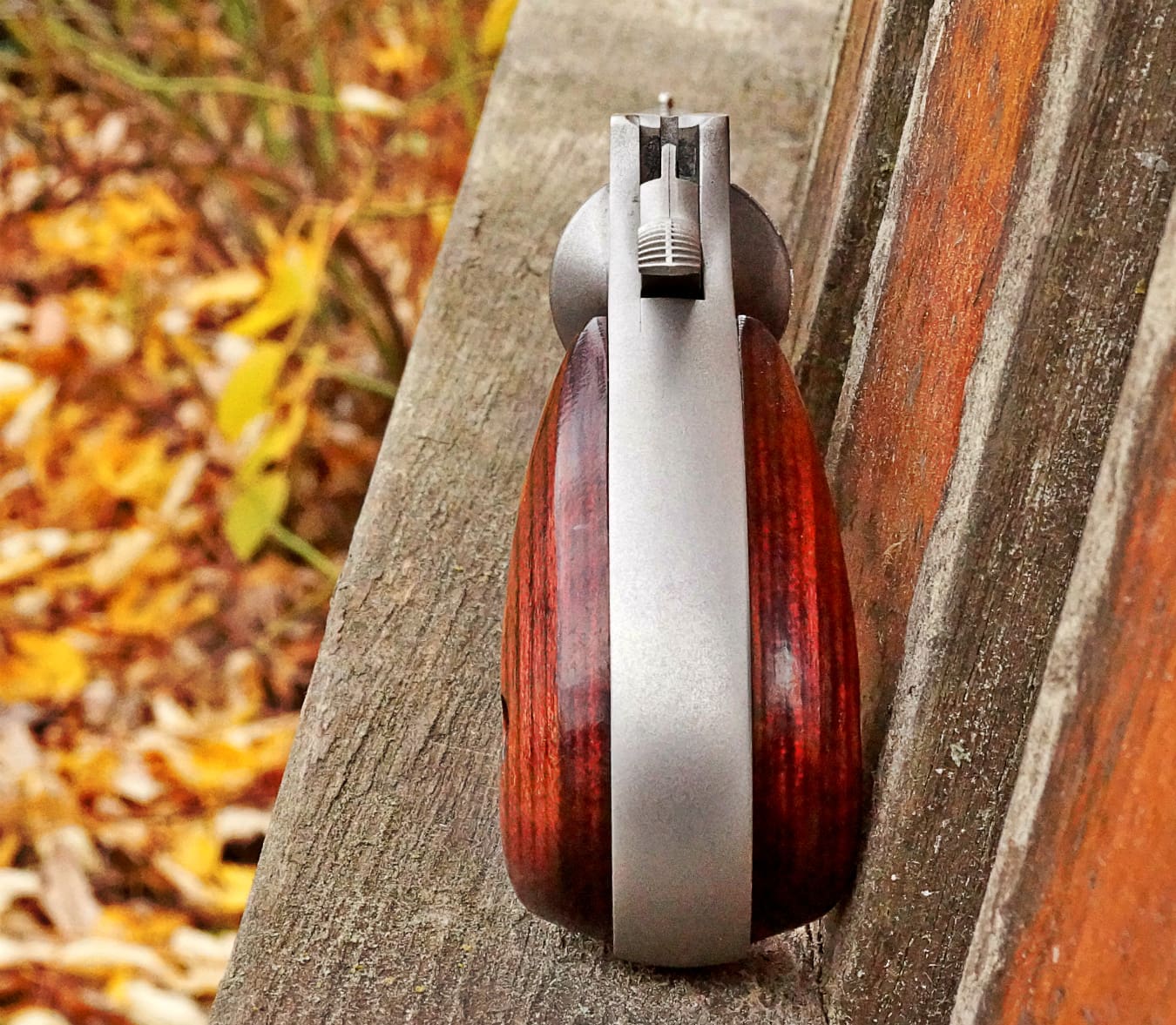
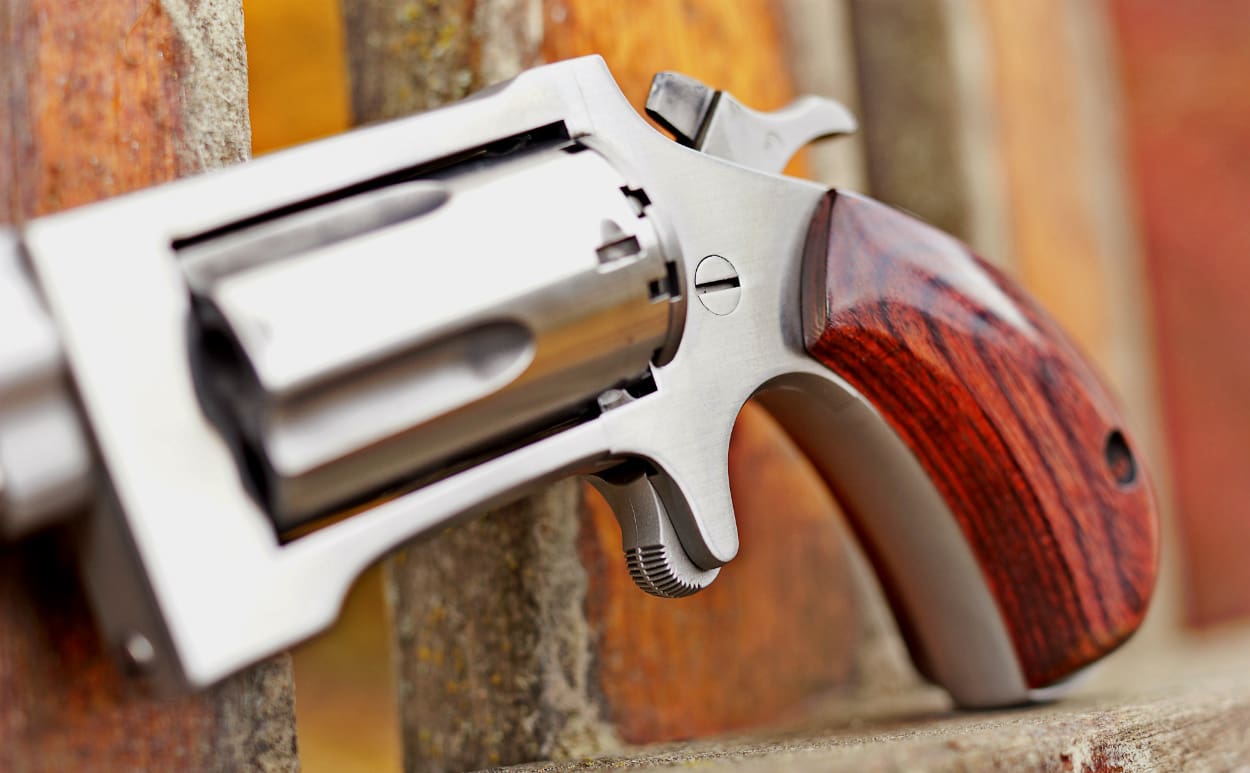

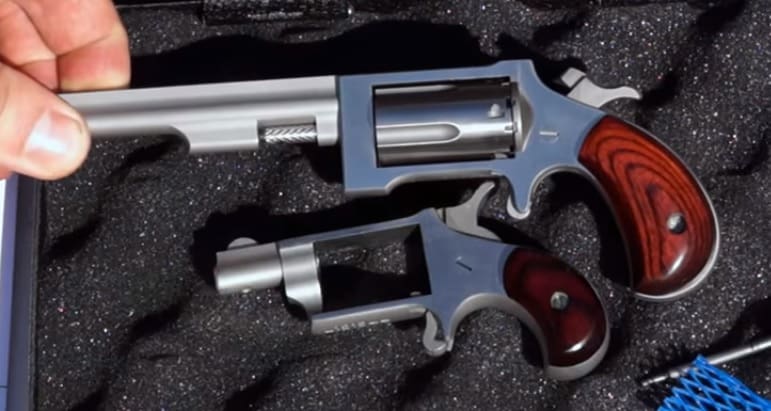
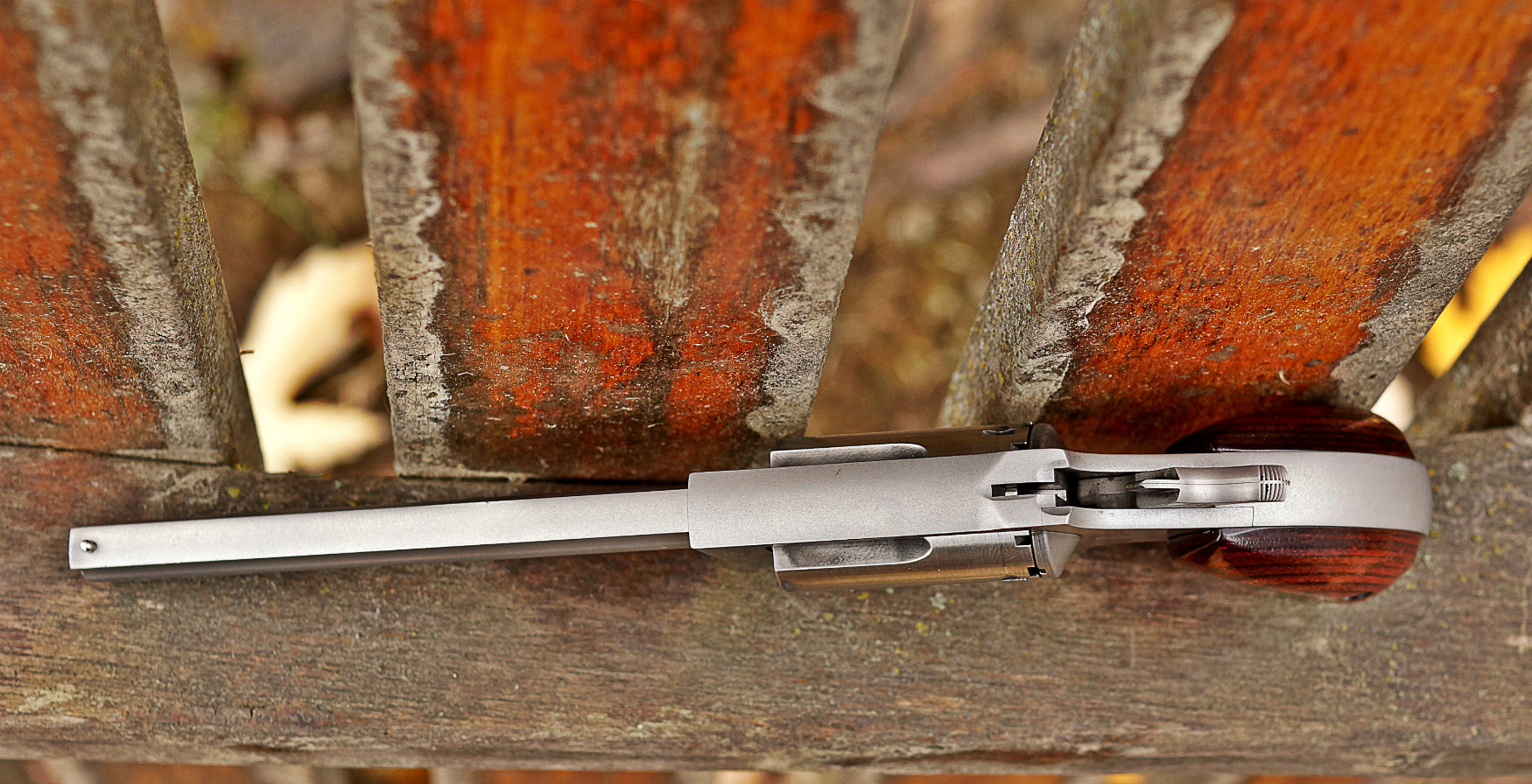





My original NAA .22LR/.22WMR 1 5/8″ model is a fun little piece, but it’s been relegated to the status of novelty safe-queen for many years.
While I appreciate the ingenuity of the existing and new models, every time I start to get my checkbook out, I ask myself what, exactly, I’m getting that I don’t already have in my current single-action six-shooter .22LR/.22WMR revolvers (Heritage and Puma). And I just can’t figure out a good-enough answer.
I saw that you have a Heritage single action .22; can you please tell me how well you like it, and is it a decent gun for the money?
I also have a heritage rough rider, 5″, 22lr, painted “metal” receiver. Basically their base model. And I love it- It’s fun to shoot, shoots anything 22LR or smaller (try CB22s through it- they sound like popcorn) and has basically no recoil. The removable cylinder makes cleaning a snap, and there are enough accessories on the official website alone (including a pretty good western gun belt) to make anyone happy. I originally bought it for my wife, but she switched to a smith 642 because the heritage is a “girl gun.” The irony is that I carry it all the time as a snake gun on my land- And it’s never failed me. Recommended,
It’s a fun gun for the money. Not a target pistol, but mine’s been reliable and a fun plinker. It’s no Ruger Single Six, but I have absolutely no regrets for the money.
My single six is a great gun. But it cost north of 450 bucks.
Ever since I saw a LR-framed mini fitted to a keychain fob years ago I said to myself, “I must have one.” Still don’t, but haven’t taken it off the wish list yet.
Where’s a 2″-3″ version? The original sub 2″ barrel is too stubby. A longer version that’s not 4″ would be appreciated since it would still be concealable, but easier to shoot more accurately.
Like the 2.5″ one they make? 😛 …see the bottom two Sidewinder options: http://northamericanarms.com/index.php/firearms/sidewinder.html
…and there are similar barrel lengths in a lot of the other models as well, I do believe…
There’s a 2.5″ inch Sidewinder:
http://northamericanarms.com/index.php/firearms/sidewinder/naa-sidewinder-518.html
Does anybody know if it would be “California legal” for someone who owned one of these 4″ models to cut it down to 3″ or 2.5″? I ask this because of the nature of California’s goofy laws. Isn’t so much that they prohibit small guns altogether, they just don’t allow them to be sold, if I understand correctly. I am talking about a “post sale” modification by the end owner.
For example, I own a P3AT (and don’t live in California). If I moved to California, I could take my P3AT with me and be ok under California law. I think I could even sell the used P3AT (through a dealer) to someone else. However, Kel-Tec cannot market their P3AT in California.
Any Californian’s have the answer to this? It doesn’t really matter to me, because I don’t intend to move to California. I was just wondering.
As long as you don’t create an assault weapon per CA law or violate NFA laws, you can modify your own property however you like. Shortening the barrel on a revolver would be a-okay.
Actually Jeremy S. Is not technically correct.
It is illegal to import any weapon that is not either listed on the roster or specifically exempted from it. By import they do mean carry across the state line as a personal possession.
You can shorten your revolver barrel but not to the point where it no longer meets the LOA requirements. Granted nothing is going to stop you but no licensed gunsmith will do it and if your weapon ever falls into law enforcement hands it will never be returned.
Friendly advice from a gun owner stranded in CA.
Bump to follow
Andrew I completely disagree with everything you’ve said. I lived in CA from 2001 to 2012 so we aren’t talking about some random dude in WA spouting his mouth off on a subject he has no experience with. The Roster applies to guns sold in CA by a dealer. It does not apply to private party sales nor to firearms you already own if you live in one state and are moving into CA. There’s a specific exemption for that. Art Out West is correct and he can bring his Kel-Tec into the state if he moves to CA. You just have to pay $19 to register guns you bring in. https://oag.ca.gov/firearms/ab991 Likewise, the Roster is a list of guns that dealers are allowed to sell to individuals, it is not a requirements doc for what you’re allowed to own. The NAA with 4″ barrel makes it on the list because of the OAL exemption and the other single action revolver caveats, but the hurdle it clears with that is the one that allows dealers to sell it. Once you own the gun, the Roster has nothing to do with anything and you can modify it however the heck you want.
The things you’re subject to no matter what are CA’s “assault weapon” rules, new magazine capacity rules, and state & federal NFA rules.
I’ll have to reread but everything I’ve read leads me to believe the ban on importation itself, not just dealer sale. I’ve spoken with my ffl they can’t tranfer a privately sold gun from out of state if it’s off roster.
Yes you have to register anything you walk into the state, but I have no reason to believe they will allow you to register anything off roster. I could be wrong, but i sure as hell ain’t going to risk it.
Not to be too blunt here, but you are in fact incorrect on this.
The Roster applies only to firearms sold by a dealer to a non-exempt person. Transferring a gun from an out of state individual does fall under the Roster’s purview according to CA DOJ, as the dealer has to take legal possession of it before then transferring it to you, and it’s dealer-to-person transfers that apply. In-state private party transfers do not count and are exempt from the Roster. Even though an FFL facilitates the background check for that, it’s still considered a direct person-to-person transfer.
This is why the Roster’s actual, CA-official title is: “Roster of Handguns Certified for Sale.” And that’s sale by licensed dealers. That’s all it applies to. The only legal requirement for importing a firearm from another state when you move is that the firearm is California legal. A lot of people confuse “CA legal” with “being on the Roster,” but that is NOT the case. As an example of that, guns don’t become illegal when they drop off the Roster and you don’t have to forfeit them. Again, it’s because the Roster only affects whether a dealer can sell them, not whether you can own them.
https://oag.ca.gov/firearms/pubfaqs#25
This is why that whole Single Shot Exemption thing was going on for years in CA until they created a law to specifically stop it. By selling a pistol in single shot form it was exempt from the Roster. Then the owner could legally do whatever they wanted, including modifying it back to normal, semi-auto form. Totally legal, because the Roster only applies to dealers.
Sorry to be repetitive, but the most important takeaway for a CA gun owner concerned with what they can and cannot be in possession of is that the Roster is NOT a list of what’s legal to own. It is only a list of what a dealer is allowed to sell you and it is absolutely nothing more than that.
BTW as a CA resident there’s still one way to get new or used off-roster guns from out of state, and that’s if they’re a gift from a family member who lives out of state. And it has to be direct lineage family, meaning grandparent, parent, or child relationships. Siblings don’t count.
Ok very good
I still have no desire to remain living here and i highly discourage anyone contemplating moving here from doing so.
Andrew. I’ve known folks that moved here and registered their firearms after they did. When you ask an ffl from outside the state to transfer a weapon to a CA ffl that becomes a problem. Ffl’s have to abide by the register.
I don’t remember all the details. But a time limit is imposed on people importing their own firearms into the state for registration.
I still say there is no good reason to come to California. Doubly so if you are a gun owner.
You have 60 days to register them from the time you bring them across the border.
There are great Wikis and flowcharts on CalGuns.net’s forums, and about 100,000 threads on every conceivable CA legality question. People are happy to link to all of the relevant laws over and over and over, or just point folks to the Wiki.
Obviously, one big reason the CA gun laws are such a ridiculous labyrinthine quagmire of confusion is to discourage people from owning guns. I can’t even begin to count how many friends and acquaintances I had in CA who wanted to own a gun but were so afraid of accidently running afoul of some random law that they never did. You need a freaking law degree and a lot of time on your hands to plow through it. Then two more times to retain it. Additionally, for all of the people who don’t have the resources or education to wade through the myriad, absurd, conflicting and confusing laws, it all but guarantees that CA can pin a crime on them. Gun owner who didn’t make a list and check it twice? Probably a criminal in some way in CA. Not to mention random jurisdictions like San Francisco that may impose their own laws like hollow-point bans and safe storage requirements, etc. It’s a shit show.
The NAA’s I find most aesthetically pleasing are the “Earl” variations:
http://northamericanarms.com/index.php/firearms/earl.html
They still use the older drop-out cylinder loading method, but, c’mon, fast reloading isn’t what you buy an NAA mini for.
I consider the drop-out cylinder a reminder: if the problem isn’t one that can be solved with five rounds of .22WMR, you should probably consider running away, if possible. 🙂
If looking for accuracy in NAA’s, then the Black Widow and Mini Master models are the way to go. They have a rear sight and a ramped front in both fixed and adjustable variety. Better sights can make all the difference.
I’ll take a Canada-legal 4.2″ barreled version please. It’ll go nicely with my wife’s Ruger Single Ten.
I’m a fan of NAA revolvers, but in this example, the tool marks on the back of each cylinder look atrocious. I have to wonder why NAA didn’t finish that surface.
A lot of that is my fault. HDR photo creates contrast sometimes that really isn’t visible to the naked eye. In this case, that actually is pretty much the only spot on the gun that has some visible tool marks (from being ground flush, by the look of it, and NAA didn’t bead blast it afterwards like most of the rest of the gun), but the HDR photo really makes them pop out like crazy. …Also, as you can tell even more clearly in some of the other photos, it isn’t a new gun. I had shot a bunch of rounds through it before taking pictures, which is always a mistake with rimfire especially.
Yup. I turned my HDR off. Pictures look much better now.
I typically like it, and basically all of the photos in this review have some degree of it. It certainly makes the stain left on the wood background much richer, as it’s reflective enough to wash itself out if the camera is set to expose the gun properly instead. There was a lot of HDR range going on in that cylinder photo to make the inside of the chambers visible without completely blowing out the rest of the photograph into a white haze. I didn’t actually notice how much it exaggerated the texture on the cylinder faces and even the bead blast texture on the recoil shield. Can’t win ’em all! But compared to the photos I took two years ago for the other NAA Mini Revolver review (http://www.thetruthaboutguns.com/2014/04/jeremy-s/gun-review-naa-mini-revolver/), which are generally kind of grey and sad, I hope you’ll agree that these are significantly better.
My understanding is that .22 WMR requires a slightly larger bore than .22LR. This very often causes .22 LR accuracy to suffer from a dual cylinder revolver.
The thousandth of an inch difference in bullet diameter doesn’t much matter, but with actual copper jackets on a lot of .22 WMR projectiles they do typically run a larger bore by a couple of thousandths (.224 vs .222) to accommodate that. This plus free bore inside of the cylinder definitely does explain less accuracy with .22 LR.
The ‘Black Widow’ rubber grips will fit that gun…
As-is, that will make a dandy boot pistol…
In the video you said you swim with a NAA gun? No rust? Amazing!
Yeah my Mini has been in different bodies of water a bunch of times. I’m not sure if the hammer spring is stainless steel, but if it isn’t it’s coated with something that has prevented it from showing any signs of rust. The rest of the gun is all stainless (or wood).
Hey, Jeremy –
Who does that smooth guitar riff in your vids?
If it was you, what axe, amp, etc?
LOL. Just royalty free / license free stuff since you can’t use copyrighted music on YT in this manner unless you pay royalties. It’s this one: http://incompetech.com/music/royalty-free/index.html?isrc=USUAN1100609
I can think of a really good reason to get one of these. It’s stainless steel. Put rubber boot grips on it and load it with 2 snake shot and 3 hollow points and use it as a gold panning companion.
I frequently wind up in water up to my chin when I’m hunting gold. It’s my primary reason for a stainless Mora and it’s craptastic plastic sheath.
I had one of these much earlier in 2015 and had issues with it opening on the shot causing damage to the forcing cone and lead ejected from the side. I had two go rounds with customer service, same issue both times. Suffice it to say NAA CS was great, easy, and made it right, and I HIGHLY recommend the more solid “pin through frame” design of their other offerings. Given their good customer service it would be worth trying this if you really think you need the swing out cylinder, but again, I highly recommend the original design as more robust (and doesn’t take that much more effort to reload). I have several of their products and will have several more in the future, this was the only one I had problems with.
My personal favorite NAA offering is the Earl (in 3″) and I think it would be a better alternative if you are interested in the Sidewinder. The black window and mini master are also great and very reliable I ended up with a Pug in place of the Sidewinder and it’s awesome.
-D
I agree with Don. I never saw the need for a swing-out cylinder, or even the break-top design. With these you must eject and load 5 rounds. At least with the removable cylinder design you can swap the spent cylinder for another fully loaded cylinder. But these little guns are not about reloads anyway.
It isn’t about reloading in the middle of a gunfight or anything, just general convenience and ease. And maybe safety as well. If you’re standing out there with the normal one you’re dealing with 3 separate pieces to the gun and manually ejecting cases one at a time with the cylinder pin then holding those 3 pieces while reloading, etc. Dropping a cylinder with live rounds in it has the potential to be a bad thing, as it could land primer side down on something hard/sharp (pebble or whatever) and ignite a round. Not likely, obviously, but possible and I know it’s happened with centerfire guns with removable cylinders but not sure if it has happened on a rimfire. Anyway, dropping it is made easier by having to juggle 3 pieces plus loose rounds. The swing-out cylinder keeps the gun assembled as one piece, and all 5 rounds eject at one time with a tap of the finger on the ejector. Then it’s much simpler to make the gun ready to fire again by just pushing the cylinder back into the frame. Although I don’t find the alignment and pin insertion difficult in the normal one at all, I’ve had practice with it and most people do find it hard to accomplish. The swing-out cylinder with ejector is just more user friendly, which is why I think it’s a step up.
i currently own an 11 year old black widow, and a 4in sidewinder. my experience is probably not typical as i buy a gun to shoot, a lot. the black widow as delivered had sights that could not be regulated enough to impact point of aim. i sent the gun back and naa did attempt to fix the issue but still does not have enough adjustability. i love the fit and finish and the oversize rubber grips really make a lot of difference. the slow to reload factor and poor sight regulation dampened the fun to shoot factor. now, i hoped the 4in sidewinder would eliminate at least one of the problems and does. if it had the oversize rubber grips and real adjustable sights one could come close to full size gun accuracy. my hope for the future ranger models would be to add real sights and grips and let us plinkers have an accurate, finely make “shooter”. and yes, small guns can be very accurate given the proper equipment. after all the only truly interesting guns are the accurate ones!
People talk like Californians should feel bad that a bunch of numb-skulls don’t want to move there. Life has many more aspects than just shooting a gun. California has many more opportunities for that than most other states. California contributes the most tax money to the union than any other state. If California became it’s own country, the rest of the U.S. would suffer economically. The states with the most lenient gun laws also have some of the largest accounts of unemployment and welfare assistance…true socialism. Most of California’s gun laws are adopted versions of other States’ gun laws…most of them are in affect all over the country in one place or another. A resident gun enthusiast in New York City would probably love to have California’s gun laws.
I just bought the 4 inch sidewinder and I’ll have it in a few days. Look forward to give it a review. :>) $389
Your speed and accuracy with this tiny single action is impressive. Dryfiring hurts my heart. I have a four inch minimaster with holster grip that fits in front jeans.pocket. Recommend the holster grip. Nas makes them for 22. Lr and mag. Frames.
If you love to wear polyester fabric jackets? so check Salt N Pepa Jacket which is a most selling outfit in our store, Shop now and get amazing discounts and offers.
Comments are closed.